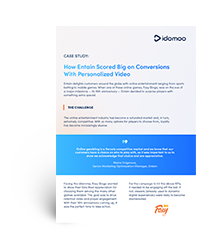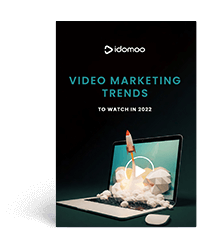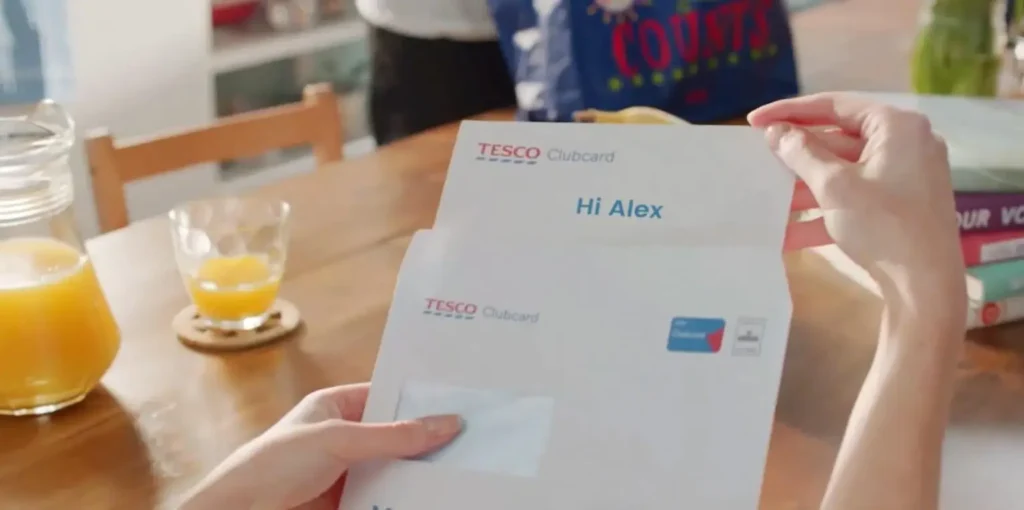There’s no denying it: video is one of the hottest topics on the web. From short videos to how-to tutorials to vlogs, videos are in demand among all demographics. Gen Z, for instance, loves TikTok — over 60% of the app’s user base is Zoomers. Millennials spend their free time, roughly 1.5 hours per day, browsing through streaming services. Even older demographics love video. Over half of baby boomers watch videos online, mostly on Facebook.
But it’s not just consumers who enjoy video. Businesses across industries are leveraging video content as a key component in their marketing strategy. According to HubSpot, over 90% of marketers see video as an important part of their marketing strategy.
It’s obvious businesses value video marketing. Conversions, customer trust, user stickiness — these are just a few of the benefits driving the popularity behind video marketing. We’ll dig deeper into how video delivers these better business results below.
The Rise of Video Marketing
How has video become the popular marketing tool it is today?
It all began with YouTube. Google bought the platform just 18 months after its launch in hopes they could tap into the power of the site’s viral videos — and it worked. Video marketing took off. Businesses began to leverage the website to get their products in front of billions of viewers, making YouTube an advertising powerhouse.
- YouTube generated $28.8 billion in ad revenue in 2021, beating Netflix’s ad revenue for the last quarter.
- Advertisements on YouTube have a potential audience of almost 3 billion users.
Video marketing strategies show no signs of slowing down, either. In fact, it’s becoming even more popular. The latest frontier full of possibilities for digital marketers is TikTok, the most visited site of 2021.
Marketers are leveraging video content not only because of its growing popularity, but also because it’s easier than ever to create high-quality videos. The video production process can be as simple as using a smartphone and a video-hosting site. In fact, some of the most popular videos are shot with just an iPhone.
Take Chipotle, for example. Just one of their TikToks has over 3 million views, and was shot in less than 30 seconds.
@chipotle Chipotle keto salad bowl > stick of butter in your coffee. Order it or any of our other Lifestyle Bowls in the app and online only. #chipotle #vegan #keto #vegetarian #whole30 #foodhacks ♬ original sound – Chipotle
With short and simple videos growing in popularity, it’s now feasible for both small businesses and large enterprises alike to reap the benefits of video marketing.
Why Video Marketing Works
We know video marketing is incredibly popular. Instagram now has an entire section dedicated to short-form videos. Meta recently announced the site will be undergoing new changes to make the entire user experience more video-centric. It’s no surprise that over 80% of businesses use video marketing.
What benefits are marketers seeing from leveraging video in their digital comms? We explain the benefits and advantages of video marketing below.
1. Boost Conversions With Video Marketing
Over 60% of people believe video views are the standard for video marketing success. While this is certainly important, what’s even more valuable is when all of those viewers turn into valuable leads or customers. Research shows nearly 80% of people have been convinced to buy something by watching a brand’s video.
This video from Entain is a great example of how video marketing increases conversion rates.
Looking to encourage customers to redeem an exclusive reward, Entain was curious as to what medium would work best to deliver the special offer. In an A/B test of messaging players in a text pop-up versus a video, the video won by a landslide: 88% of customers redeemed their reward offered in the video.
Why? A video doesn’t tell the viewer why they should take action — it shows them. Eye-catching visuals and audio work together to create a more convincing, immersive experience that appeals to customers’ buying decisions.
2. Brand Videos Build Trust
Customer trust is incredibly valuable — especially during times of high stress and uncertainty. Take the pandemic, for instance. A whopping 74% of customers reported a need for brands to communicate their efforts to deal COVID-19. Could consumers trust banks to help with their financial issues? How would airlines handle a surge in cancellations?
It was a chance for businesses to build trust among customers, or break it. So how could they achieve the latter? By telling a story that resonated with customers’ emotions, not their wallets — and the best storytelling tool available is video.
This marketing campaign from Dove is a great example. To show their commitment to helping, Dove pledged to donate over $7 million in support of healthcare workers. That alone would be impactful, but to show customers the emotions behind their mission, they put their message in a powerful video.
The brand told a story that tugged on customers’ heart strings: healthcare workers in need of support now more than ever. Plus, an emotionally powerful video such as this drives deeper connections — critical for building trust. Dove not only won their customers’ confidence, but also two awards at the Cannes Lions International Festival.
3. They’re Perfect for Marketing to Current Customers
Video marketing is perfect for your current customers. Whatever you’re trying to communicate, sending your message in a video that’s fun to watch and easy to understand improves the customer experience.
You already know what your customers want, so put your data to work with a video that speaks directly to their needs. A Personalized Video does just that, driving 8x conversions.
Tailoring your video marketing to every single customer is easy with a Personalized Video platform. Combine video creative with your customer data — or let your customers fill in their own data with interactive video. The result is a Personalized Video 100% unique for every individual.
Check out this Personalized Video campaign from AutoNation as an example.
This video is full of details personalized to the viewer. For instance: their name, the year they became a member and their car model. Personal touches like these wow and delight your current customers, which drives loyalty for the long-term.
4. Explainer Videos Break Down Complex Topics
Think about logging onto your account with your bank. It’s confusing to navigate. You end up leaving the site, frustrated and annoyed. It’s a common point of friction for many customers — one that leaves them with a bad impression of your business.
Now imagine your loan servicer emails you a video explaining how to use your account, such as the one below from Chase.
Now, you have a step-by-step guide at your fingertips. You can learn how to access and use your account in under a minute. It’s short. It’s clear. Plus, you can watch it at any time.
The above scenario is just one of many examples of why video marketing is effective in explaining any and everything to your viewers. In fact, 73% of people prefer watching a video to learn about a product or service over other mediums.
Another industry that often deals with nuanced topics is higher education. The beginning of the school year is exciting, but there’s one step students dread: applying for financial aid. It’s confusing, time-consuming and stressful.
To make the process easier, Lewis University sent out the following financial aid explainer to its students.
Students often receive pages upon pages of policies and deadlines when it comes to their financial aid, often causing information overload. This video, on the other hand, gave students a clear explanation of their financial aid in a matter of minutes. Plus, engaging visuals and scenes from campus life made the entire experience more engaging and enjoyable.
5. Video Marketing Increases Social Shares
Videos reign supreme on social media. From YouTube to TikTok to Instagram Reels, video content is what users want across platforms. Just take a look at the numbers:
- Videos are consumers’ favorite content to see from brands on social media.
- Tweets with videos are 6x more likely to be shared than Tweets with photos.
- Over 90% of those active in Instagram’s surveys say they watch videos on Instagram weekly.
Converse is one business that’s reaching its audience through eye-catching videos on their social platforms. Wouldn’t this product video make you pause as you’re scrolling through your feed?
For our latest release, we simplified our iconic Chuck 70s to be made out of less ✨
Shop your own lightweight Chuck 70 Redux sneakers now at 👉 https://t.co/OUIEFeqLAV pic.twitter.com/ThmoNrumSW
— Converse (@Converse) June 2, 2022
Videos are not only incredibly popular with users, but they’re also among the most shareable content on social media platforms — users are twice as likely to share video content with others than any other type of content.
One of the most shareable types of videos we see time and time again are highlight reels. Users receive a video recapping all of their best moments that they can then show off to friends and followers. It’s humblebragging made easy.
For businesses that aren’t sure what their viewers want to see, interactive videos, such as this one from WW (formerly Weight Watchers), allows viewers to hand-pick what they’re most proud of.
Every viewer received their very own video that they could customize to their liking, straight from the video player. Viewers could then share their achievements they hand-picked themselves with followers. Plus, celebrating every member’s accomplishments is a great way for businesses to boost brand love.
Interactive video is especially helpful when you don’t have customer data to personalize your video. With interactivity, customers share their data — in a way that’s seamless, not intrusive and even fun — helping you better understand your customer and increasing your first-party data.
6. Video Marketing and Email Marketing Work Well Together
Customers click through blocks upon blocks of text as they check their inbox. To spark their interest, you need your email campaigns to be full of content that will actually engage them.
Including video content helps your email campaigns stand out among the sea of messages your customers receive. They pack a punch with visuals and audio that tell an attention-grabbing story. Something as simple as including the word “video” in your subject line can even boost open rates by 19%.
You can make any message you’re looking to communicate via email exciting with video. Delta, for instance, was able to turn air travel into a visually stunning story with the power of video.
Imagine receiving this in your inbox. It’s short. It’s engaging. It’s personalized with your name. And, as we touched on before, videos are incredibly effective in driving conversions. Sending your customer a video like this can increase their chances of clicking on whatever CTA you have in mind, taking their customer journey beyond your inbox.
7. Google Loves Video Content
Last, but certainly not least, is Google’s love for video content. Google’s purpose is to give the end user the best search results possible, which is done by responding to what consumers’ currently want. Because of this, the search engine pulls the content most in-demand by internet users: video.
It makes sense, then, to use video in your content marketing strategy. It can increase your SEO ranking and bring in more organic traffic and potential customers.
For example, studies show including videos in a blog makes it 3x more likely to attract inbound links. These backlinks play a key role in where Google ranks your content. As your links are shared, Google will find your page to be more legitimate — and rank your content higher.
Video marketing also boosts user stickiness: another metric Google uses to determine rankings. It makes sense — a user chooses to spend time on a page because there’s value in what’s being said. These pages are most often those that include videos, meaning your pages should, too. Research shows users spend almost twice as long on pages with video than those without.
Google is just one of the top search engines that works well with video marketing, too. YouTube is the second most powerful search engine. Try creating videos for your YouTube channel, and linking to your site and other landing pages in the description of those videos, to boost brand awareness and attract new customers.
Video Marketing for Better Business Results
Whether you’re looking to launch a mobile video for smartphone savvy customers, stream live videos or leverage any other type of online video, you’re bound to see some great results like the ones we’ve explained above.
With so many companies taking part in video marketing, though, how can you stand out? Take your video campaigns to the next level by wowing your target audience with Living Video technology — videos that are interactive, contextual and even customizable. Get started by scheduling a 15-minute call.








